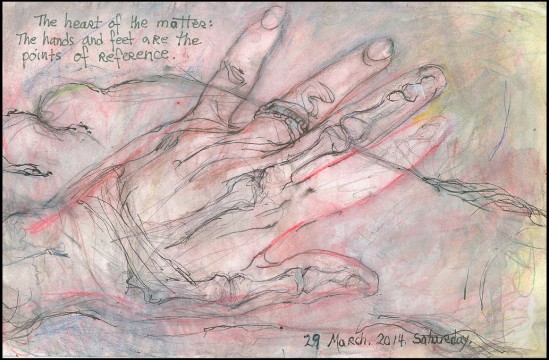Blog: DayBooks
I know I’m somewhat foot-obsessed. I’m pretty attached to the hand as well. It’s got to be safe to say that proprioception starts with the hands and feet. We, as a species, haven’t been upright for all that long. The hand still relates to the foot, to it’s movement, it’s direction. It still feels good to balance on hands and feet: downward dog, L-shaped handstand, and (the trickier and more difficult) wheel. These positions can become full explorations of evenness. The weight carried by hands and feet has to be evenly distributed or I lose my sense of position in space. (Wheel is so much more difficult for me because of the upside-down head’s effect on my crazy vestibular system, but that’s another story.)
These days I’m wearing a portable defibrillator (yes, it’s a bore — I call it Henry) and it’s battery pack. And no matter how I carry the battery pack (which is like a brick) I’m off balance. I reposition it every so often, but, believe me, there’s no good position. So I’ve had to develop a yoga for this situation: yoga with a swinging brick. And I have been relatively uncomplaining about the asymmetrical versions of poses I’ve been working with. But I have to have my wild moments of being lost in some yoga poses. So I take a break from Henry — just long enough to do L-shaped handstand, handstand and wheel and a lovely, long, saturated downward dog. (My electrophysiologist saw right away the need for this outlaw sequence, if just for self esteem.)
Hands and feet do their thing and push back at gravity. And then there’s the subtle pleasure of the rest of the skeleton lining up and participating in the chain of events. If all is well, all is lighter than air. It takes a lot of work and practice to get solidly light though. A study in contrasts.

